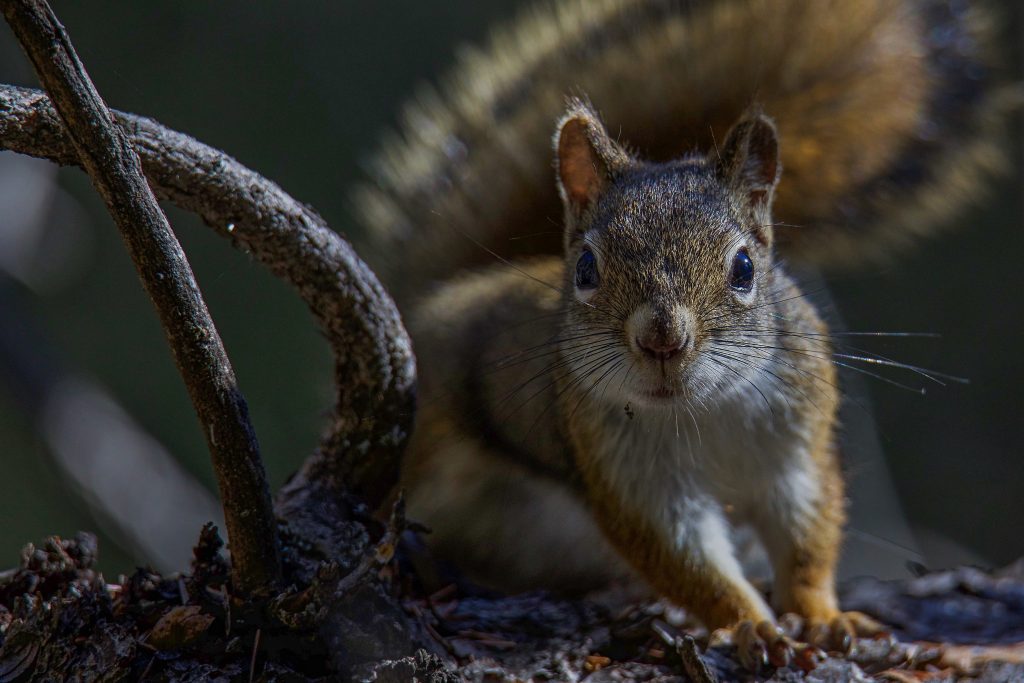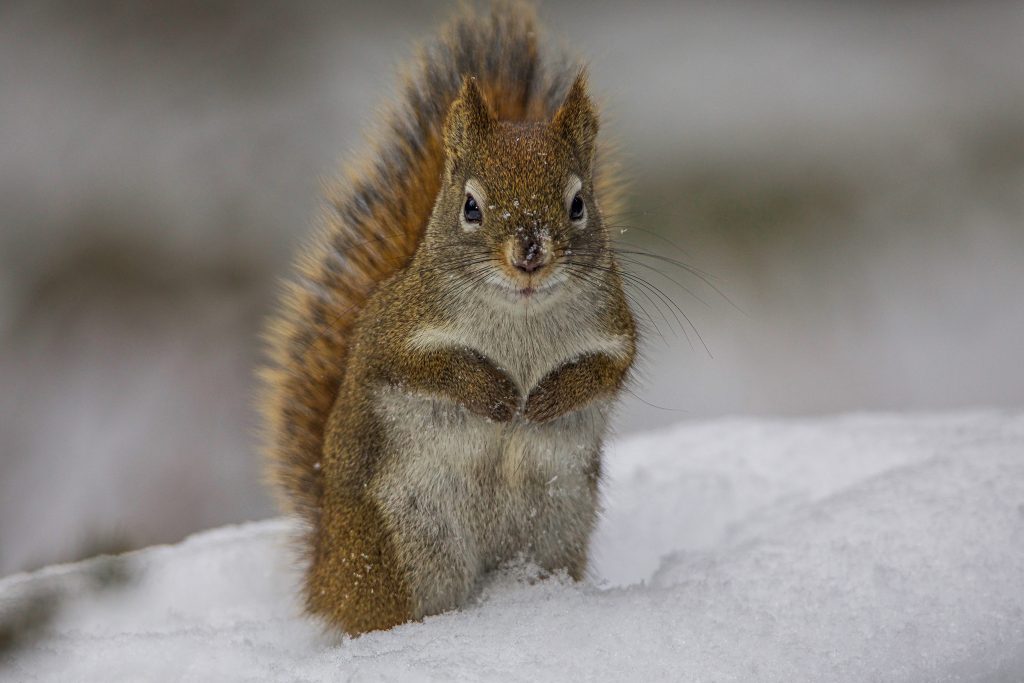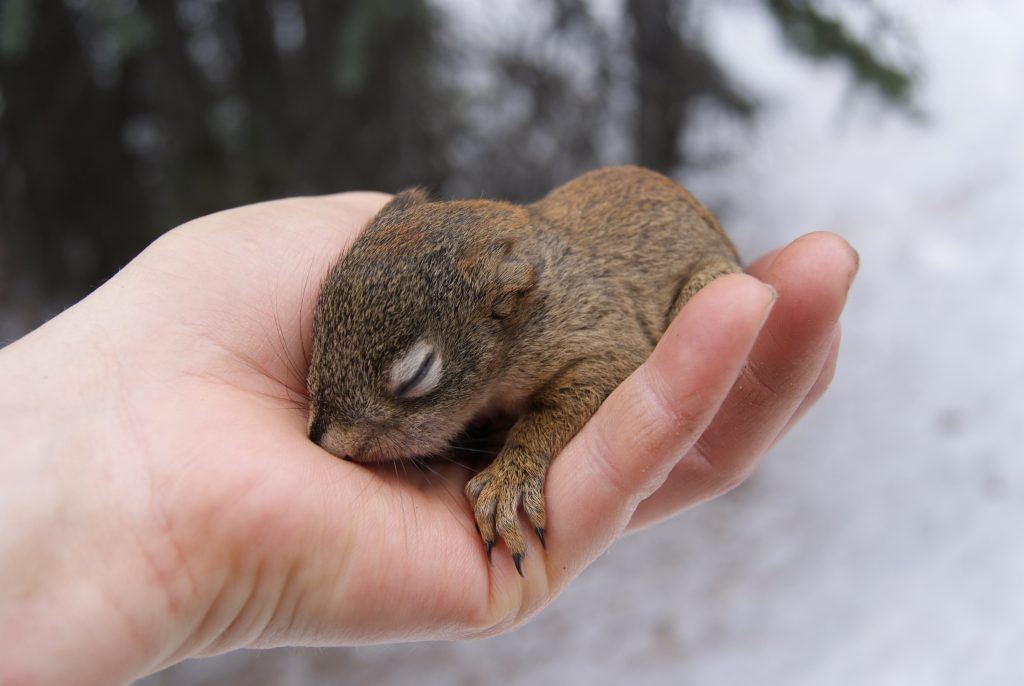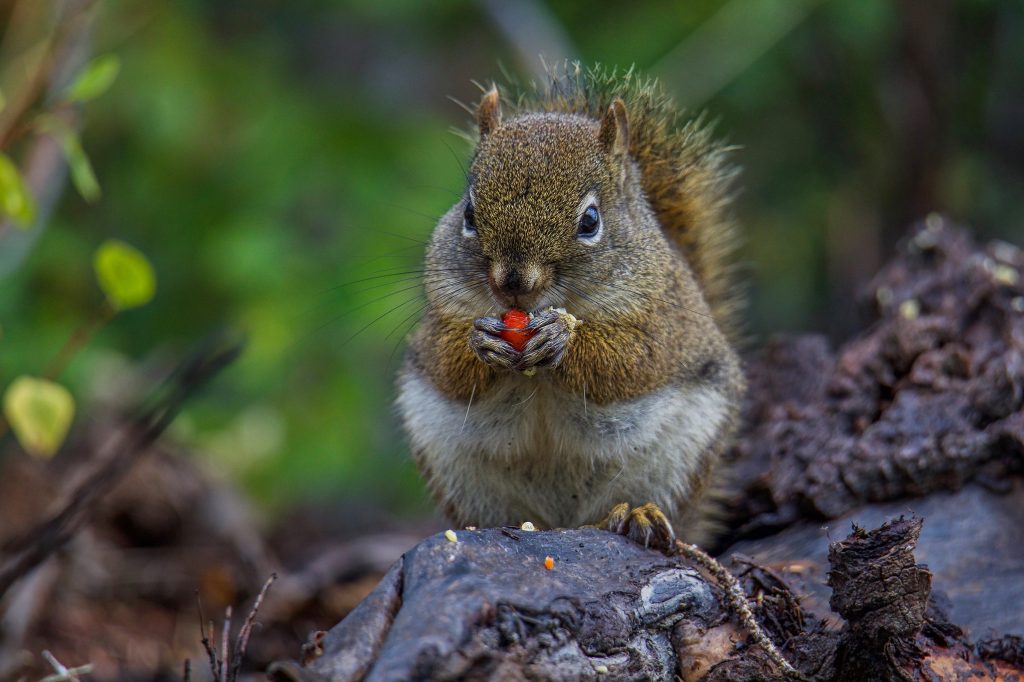Five Things I Learned from Squirrels

Red Squirrel. TONY LEPRIEUR
BY JESSICA HAINES
I’m a wildlife biologist with a passion for squirrels. I’m currently working on Franklin’s ground squirrels in collaboration with Nature Alberta (check out the Winter 2023 edition of Nature Alberta Magazine for more info on that project). But before that, I spent several years working on red squirrels with the Kluane Red Squirrel Project based in the Yukon. Living and working in such a beautiful, remote place was thrilling, but what surprised me was how much I fell in love with red squirrels. They taught me a lot, and I would like to share with you some of the things I’ve learned.
1. Squirrels are Tough

Red squirrels do not hibernate and on warm winter days you are likely to see them out and about. TONY LEPRIEUR
Red squirrels aren’t very big, they don’t store fat like ground squirrels, and they don’t have fluffy fur like many northern mammals. Nevertheless, they thrive under the harshest winter conditions without hibernating. I found this remarkable, given that some days I wore so many layers to stay warm I had to waddle around to do my field work. Red squirrels survive through the depths of winter by being very smart about their activity. On the coldest days they spend most of their time napping in nests, also called dreys, to stay warm. On warmer days they are out and about again, scampering through the trees.
Even more impressive is that red squirrels can have their pups in the winter! Pups are born blind and naked, and their mother keeps them warm and safe in the nest for several weeks until they grow fur and open their eyes. At that point, they start to climb the nest tree and explore the world on their own. The females care for the pups on their own, as males have no role in rearing the pups. I love to look for squirrel nests in winter, when they stand out on the bare branches of trees. But red squirrels will move their pups if they think a predator has found their nest (and inquisitive humans qualify), so please only observe from a distance.
2. Squirrels Take Care of Their Family

Baby squirrels, called pups, are born in late winter. This one was temporarily removed from the nest as part of population monitoring in Kluane, Yukon. JESSICA HAINES
Red squirrels are very territorial and they do not hesitate to chase invaders off their territory. Even pups are chased off once it is late summer, as this is the time for them to begin living on their own. Interestingly, though, not all red squirrel mothers do this. Some will give up their territories to one of their pups; this is called bequeathal. The mother then moves on to a new territory, often close to their original territory. The result is that some patches of forest are actually full of related females who live near each other. Such fascinating insights were possible because we tracked squirrels for generations.
Red squirrels have other ways to take care of their families besides bequeathal. They have also been known to adopt relatives! This is rare, but it can happen when a female that lives near her own mother or sister dies. One of these relatives may take in a pup from the squirrel who has died and raise it with their own litter. We’ve also found adult squirrels sharing nests in the winter when it’s very cold. We think it’s a strategy that neighbouring relatives may use to get through the coldest days of the year. This is common in more social species, but unusual in red squirrels since they’re usually so territorial.
3. Squirrels Hoard Food
One reason squirrels defend their territory so vigorously is to protect their food supply. Red squirrels create caches, called middens, where they store their food in underground tunnels. In the Yukon, their main food is white spruce cones. When stored underground, these cones stay cool, like in a fridge, and this keeps the cones closed. If left above ground, these cones would warm up and open, releasing and dispersing the seeds the squirrels want to eat. In Alberta, these middens can include hazelnuts and cones from other conifer trees. Red squirrels will also dry out mushrooms by harvesting them and hanging them in trees.
Through my research, I found that males and females have distinctly different middens. Males store more food than females, caching piles and piles of cones. I also found that males with more food in their middens fathered more offspring than other males. We believe this is because males have their highest energy demands during late winter, when stored food is all that is available.
Red squirrels have a scramble competition mating system, which means that males have to cover a lot of ground to mate with as many females as possible during the mating season. Studies on squirrel metabolism have shown that this is as energetically demanding as lactation is for females. So, just like peacocks use flashy tails to attract females and bull moose use antlers to fight other males, male red squirrels use the food stored in their cache as fuel for their mating behaviour in the dead of winter.
The linkage between cone storage and reproductive success was not as evident in females. Although females can have their pups in winter when it’s quite cold, studies have shown that their peak in energy demand actually occurs during spring, when pups are large and still nursing. This usually happens around the time when spring growth provides the squirrels with fresh foods to eat. Consequently, females are less reliant on stored food than males.
4. Squirrels Plan for (and Predict!) the Future
The trees that red squirrels depend on are masting species: they have years of low cone production followed by a year of very high cone production (called a mast year). It’s thought that this is a strategy to protect their cones from cone predators like squirrels. It is referred to as the predator satiation hypothesis. In mast years, trees produce so many cones that cone predators can’t possibly consume or cache all of them, so many cones (and the seeds they contain) escape predation and can grow into seedlings. I have experienced a few mast years, both in Alberta and in the Yukon, and it’s an incredible sight to see the tops of trees completely covered with cones.
Trees begin growing their cones in spring, but it takes until late summer for the cones to mature. This is when red squirrels target them for harvesting. You may have seen this behaviour; I have had people tell me about red squirrels throwing cones at them. In reality, the red squirrels are simply harvesting cones. First, they detach the cones and throw them to the ground one at a time. If it seems like it’s raining cones in the fall, look up and there’s probably a squirrel above you. Then they switch to caching. They’ll collect all the cones they harvested, one by one, and store them in their midden.
In mast years, red squirrels get a chance to cache lots of cones in their midden, but this isn’t the only way they react to these bumper crops. Red squirrels also respond by breeding multiple times in the season. Their offspring have a better chance of surviving and finding a place to live in a fall with abundant food. The thing is, squirrels breed before the trees produce their cones. How are they able to predict future food availability? We don’t know for sure; however, one hypothesis is that by eating buds from the trees they are able to detect a plant hormone associated with masting. We have more to learn about these smart little mammals!
5. Squirrels Aren’t Herbivores

In addition to cones, red squirrels eat berries and mushrooms, as well as bird eggs, baby birds, and small mammals — including, occasionally, other squirrels. TONY LEPRIEUR
Most people know that red squirrels eat spruce cones, and indeed, cones are a big part of their diet. But did you know that red squirrels are actually omnivores? They will eat bird eggs and chicks, and they’ll even kill and eat baby snowshoe hares. They are also excellent at scavenging. We would sometimes find animal bones or pieces of dead animals cached in trees above squirrel middens. I found it a bit disconcerting when working in an isolated field site to look up to see a red squirrel staring at me as it chewed on a bone.
Red squirrels have even been observed to engage in infanticide and cannibalism. When I was doing field work in 2014, I witnessed a male in a conflict with a female, which resulted in him killing one of her babies in front of me. My hands shook as I held my binoculars, observing these interactions. On the one hand, it was interesting to observe a behaviour we had never seen before, but on the other it was shocking to actually witness it. Infanticide has only been documented in mast years since females will breed multiple times in those years. This gives a male a second chance at fatherhood if he manages to kill a female’s offspring and cause her to breed again. The male who I observed committing infanticide went on to sire all of the offspring that female produced in her next litter. Although reproduction is the main motivation of this behaviour, males did also sometimes cannibalize the babies killed by infanticide, adding yet another shocking item to the list of foods we know squirrels will eat.
In Conclusion: Squirrels Are Fascinating
I didn’t start out with ambitions to become a squirrel expert. To be honest, I was more drawn to the idea of working in an isolated field camp in the Yukon than the idea of working with red squirrels. But once I started working with them, they quickly won me over with their personality and tenacity in the harsh environments they live in. They are a fascinating species with complex lives. If you would like to continue learning more about squirrels, you can contribute to the citizen science project on Franklin’s ground squirrels. Visit naturealberta.ca/citizen-science for more information.
Dr. Jessica Haines is a wildlife biologist and an assistant professor at MacEwan University. She is currently working on Franklin’s ground squirrels in collaboration with Nature Alberta. In her spare time, she loves to get outside to explore Alberta with her two Labrador retrievers.
This article originally ran in Nature Alberta Magazine – Summer 2023.
